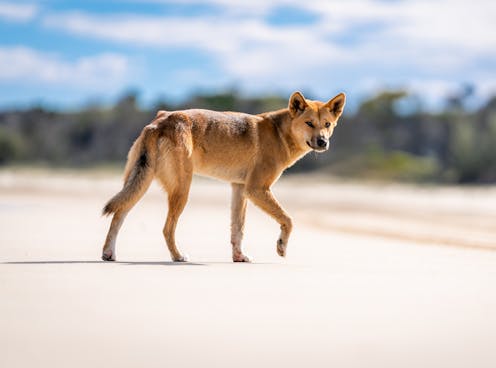What were dingoes like before the European invasion? Centuries-old DNA reveals a surprising history
- Written by Yassine Souilmi, Group Leader, Genomics and Bioinformatics, Australian Centre for Ancient DNA, University of Adelaide

For at least 3,500 years, dingoes have been Australia’s top terrestrial predator. And in current times, they are one of the continent’s most iconic but controversial animals. Dingoes hold significant cultural value, including a long connection with Aboriginal and Torres Strait Islander peoples.
Dingoes also play a crucial ecological role, helping to regulate the population of native animals such as kangaroos, and feral animals such as rabbits and cats.
However, while dingoes are protected in some national parks, in many areas they are persecuted and commonly killed.
Our ability to trace the origins, arrival and history of the dingo has been limited by potential interbreeding with introduced modern dog breeds since the British invasion.
Our team used ancient DNA sourced from dingo bones predating the European invasion of Australia’s east and west coasts to help answer all of these questions. Our study is now published in the Proceedings of the National Academy of Sciences.
Turning back the clock
To circumvent the ambiguity introduced by any potential interbreeding between dingoes and modern dog breeds, our team collected 42 ancient dingo skeletal remains. Our collection included dingoes ranging in age from 400 to 2,746 years from all around Australia.
We successfully extracted ancient DNA from these skeletal remains, effectively rolling back the clock to take a rare glimpse into the genetic makeup of dingoes in the past, free from any modern dog interbreeding.
By examining these ancient genomes, we can trace the lineage of dingoes back thousands of years and understand how their populations have changed over time.
Two groups of dingoes
Modern dingoes are classified today into two major geographical groups, East and West.
How did this grouping arise? One theory has been that the groups were separated by the dingo fence built in the late 19th to mid-20th century. It divides the southeast of the continent from the rest.
However, our study of ancient genomes shows that genetic differences between the East and West groups emerged well before the European invasion.
This suggests dingoes adapted to their environments and formed separate populations in different regions of Australia thousands of years ago, highlighting the resilience and adaptability of dingoes in various Australian landscapes.
An unlikely link with New Guinea
To our surprise, we uncovered an unlikely genetic connection between ancient dingoes from coastal New South Wales and the endangered New Guinea singing dogs.
New Guinea singing dogs are wild roaming dogs, currently only found in small numbers in New Guinea’s highlands. They are known for their melodious howls. They are the closest known relative of dingoes, and look similar to them.
Our study suggests at least one wave of migration between New Guinea singing dogs and dingoes roughly 2,500 years ago, at least a thousand years after dingoes arrived in Australia.
Given the length of the sea crossing from New Guinea to Australia, dingoes must have moved with human populations as companion animals, likely during trade.
This genetic link with New Guinea singing dogs confirms evidence for regional movement of humans provided by recent finds of pottery of similar age from New South Wales and far north Queensland.
Little mixing with modern dogs
Contrary to previous concerns, our tests showed modern dingoes have retained much of their ancient genetic makeup, with little genomic ancestry from post-colonial interbreeding with domestic dog breeds.
This finding highlights the importance of populations protected in national parks, such as the iconic “Wongari” population of K’gari (briefly named Fraser Island in post-colonial times), which was represented by three individuals in our study. The ongoing culling of dingoes in much of Australia makes this protection even more important.
Read more: New DNA testing shatters 'wild dog' myth: most dingoes are pure
By providing a clearer understanding of the genetic heritage and population history of dingoes, our research supports efforts to preserve the ecological role and cultural significance of these animals in Australia.
Our study confirms that modern dingoes remain genetically distinct and preserve their ancient heritage. They are crucial for the conservation and management of dingo populations.
Authors: Yassine Souilmi, Group Leader, Genomics and Bioinformatics, Australian Centre for Ancient DNA, University of Adelaide





